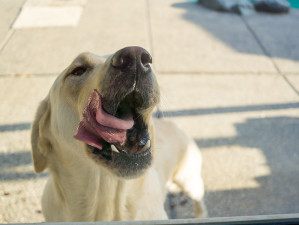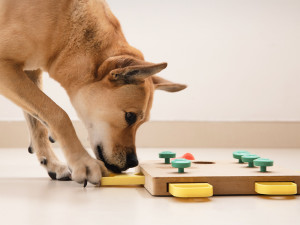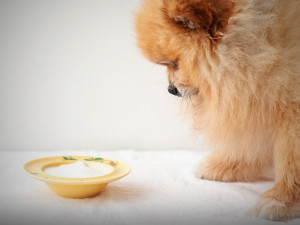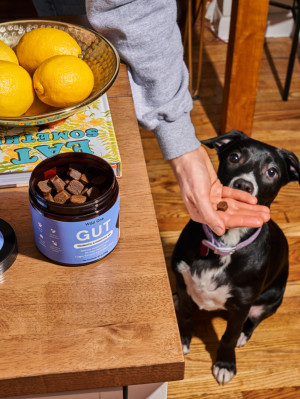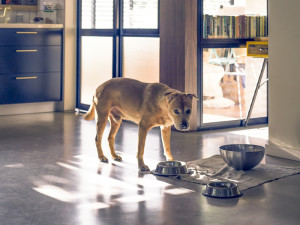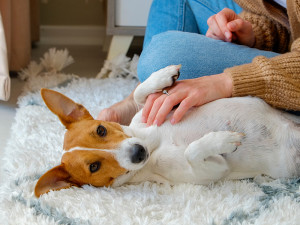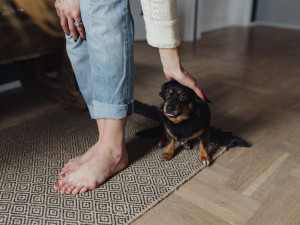Pica in Dogs: Causes, Symptoms and Treatment of Pica
Why—oh, why—is your dog eating everything they shouldn’t?

share article
Pica is a disorder that causes dogs to eat non-food items (yes, it does exist outside of that episode of Grey’s Anatomy you watched). Most dog parents have experienced pica to some degree, especially with puppies and younger dogs. Whether it’s finding your favorite shoes with a few stylish bites in them, noticing an undergarment or two is suddenly missing, or realizing your dog’s favorite toy is no longer squeaking, many dog parents have pups who have a knack for chewing on and/or swallowing foreign objects.
And while puppy chewing behaviors may be normal and are likely to be outgrown, dogs who continue to chew on and/or swallow foreign objects may have more serious underlying health problems. Pica can be caused by a number of factors, including medical and behavioral conditions. Pica can also put your dog at risk for health complications, depending on what they eat. If you suspect your dog may have pica, it is important to see a veterinarian to rule out any underlying medical conditions and develop a treatment plan.
Pica is a fairly common condition in dogs defined by their urge to eat non-edible items. This can be a frustrating condition for pet parents to manage because these behaviors can be destructive if dogs are eating things of value around the home. They also put dogs at risk for dangerous complications and put their parents at risk for those unexpected and very expensive emergency vet visitsopens in a new tab.
There are many possible underlying causes for pica, so it’s important to see your vet if you notice your dog continuing to chew on and/or eat non-food items. The sooner you and your vet can figure out the underlying cause and start the right treatment, the better the outcome for your dog, your shoe collection, and your relationship with your pup.
What is pica?
Pica is defined as a condition in which dogs repeatedly eat non-edible items that serve no benefit to them. A dog with pica disorder may ingest anything from rocks to fabric to drywall to dirt — and anything else they can get their paws on.
Some dogs may do this once, or just occasionally, and that does not qualify as having pica. Dogs who are considered to have pics do this frequently and cannot be easily redirected or deterred from the behavior.
What are the causes of pica in dogs?
Causes of pica in dogs include both medical and behavioral conditions. It can be helpful to group them into broad categories that include:
Neurological conditions: Disorders of the central nervous system, aka brain, can sometimes lead to pica in dogs. This includes congenital conditions as well as acquired conditions, such as head trauma, cancer, and/or certain infections.
Gastrointestinal conditions: This is one of the most common categories of disorders that lead to pica in dogs. Pica may occur due to pain within the digestive tract or conditions that interfere with normal absorption of nutrients. Some of the most common conditions include intestinal parasitesopens in a new tab, food allergies, exocrine pancreatic insufficiency (EPI), and protein-losing enteropathy.
Deficiencies: Dogs with deficiencies in vitamins, minerals or other critical factors may crave non-food items in an attempt to resolve their deficiency. This includes vitamin B12, as well as dogs with anemiaopens in a new tab, or low red blood cell counts.
Behavioral conditions: Other cases of pica are the result of behavioral conditionsopens in a new tab, such as anxiety, compulsive disorder, and/or boredom. This can only be confirmed after medical causes are ruled out with a thorough diagnostic evaluation.
What are the symptoms of pica in dogs?
Pica signs and symptoms in dogs may vary, depending on the underlying cause for their condition. The main symptom that defines the condition is continuously eating non-food items. Dogs with pica often vomitopens in a new tab as well, but it’s usually difficult to determine if this is the result of eating foreign material, versus part of the underlying cause.
Other symptoms can be clues to the underlying cause for a dog’s pica, so it is a good idea to keep track of any other behavioral or physical abnormalities you notice with your dog. This can help your vet put together a complete picture of your dog’s condition and focus on the most likely causes and effective treatments.
How is pica diagnosed?
Diagnosing pica in dogs takes some patience because there are many possible causes to work through. Your vet will start opens in a new tabwith taking a thorough history to understand the nature of the behavior and then performing a complete physical exam, including a neurological evaluation. In order to look for signs of some of the most common digestive conditions that may cause pica, your dog will need blood tests as well as imaging to look for any abnormalities within these organs.
This may include X-rays and an ultrasound of your dog’s abdomen to look at their internal organs. In many cases, a thorough evaluation will also include biopsies, or tiny tissue samples taken from the digestive tract to be analyzed for signs of disease. Sometimes, vets will also do a therapeutic trial, such as trying a medication or diet modification to see if the signs of pica improve in response to a treatment.
If all of these tests are normal, it is likely that there is a behavioral cause for pica. A veterinarian and/or veterinary behaviorist can help you to determine which behaviors are likely to be causing the pica, based on your observations and a behavioral evaluation.
What are the treatment options for pica in dogs?
Treatment for pica in dogs is largely based on what the underlying cause is, so it is very important to trudge through all of the trips to the vet and all of the diagnostic tests to get an accurate picture of what’s going on with your pup.
If your vet discovers an underlying medical cause, the condition will need to be treated, likely with medication and/or a special diet, in order to help resolve your dog’s desire to eat foreign objects.
If your vet determines that your dog’s pica is behavioral, treatment will be based on a combination of behavior modification techniquesopens in a new tab, mental enrichment, and medications. It’s important to have a thorough behavioral analysis performed by your vet and/or a veterinary behaviorist to best understand if your dog’s behavior is related to anxiety, compulsive disorder, or boredom. In some cases, behavior modification needs to be paired with medications to help dogs recover effectively.
All dogs with pica can also benefit from preventative strategies aimed at keeping them safe and keeping foreign objects out of reach. This helps to avoid serious consequences of eating objects that could be toxic or cause intestinal obstructionsopens in a new tab. The more proactive pet parents can be with treatment and preventative strategies, the better chance a dog with pica has for recovery and a long and happy life with their family.
Are there natural remedies for managing pica in dogs?
Pica is an indication of a serious underlying medical or behavioral condition, so home remedies alone are not sufficient to treat — or possibly cure — pica in dogs. These cases need aggressive treatment in order to prevent serious complications. It’s possible and helpful to complement medical treatments with some home remedies for pica in dogs. Some of these strategies include:
Dog-proofing: All homes with dogs should be dog-proofedopens in a new tab to some degree, but if you live with a dog who has pica, you’ll have to be even more vigilant about keeping temptation out of reach. Be especially mindful of removing objects that may be toxic if consumed, such as cleaning supplies, toxic plantsopens in a new tab, human medications, and certain foodsopens in a new tab. Consider crate-trainingopens in a new tab your dog and/or blocking off part of your home where they can roam more safely.
Basket muzzle: Dogs who have repeatedly eaten foreign objects causing poisoning or an intestinal obstruction should be trained to comfortably wear a basket muzzleopens in a new tab. These are special muzzles that prevent them from eating things but are not snug around their mouth. This way they can still pant, take treats from you, and wear the muzzle comfortably.
It’s important to train dogs to wear it with positive reinforcement training so it is associated with good things, like treats and praise, and is not seen as a punishment. If your dog learns to wear the basket muzzle, it can be a lifesaving tool to keep them safe when you can’t completely dog-proof their environment, such as on walksopens in a new tab, or when they are unsupervised for short periods of time.
Supplements for pica in dogs: Because some dogs may have digestive problems that cause their pica, some of these dogs may benefit from probioticsopens in a new tab. Probiotics provide live strains of beneficial microbes to the gut and can help with some digestive conditions. Probiotics alone cannot cure the conditions that may lead to pica, so it is important to work with your vet to get the best treatment plan in place for your dog.
Exercise: All dogs need to get enough daily exerciseopens in a new tab to keep them mentally and physically fit. This is especially important for dogs with certain behavioral conditions, including those that may cause pica. Some dogs will need an hour or more of intense activity, depending on their needs, so be sure you are keeping up. Whether it is an early morning run, daily walks with a dog walker, doggie daycareopens in a new tab, or a post-work exercise session, you will see a big difference in your pup when they are getting enough exercise.
Mental enrichment: All dogs need mental enrichmentopens in a new tab, and dogs who have behavioral causes of pica may need additional challenges throughout their day to keep their minds busy. This can include training sessions, interactive toysopens in a new tab, puzzle feeders, obstacle courses, and more. If you need ideas on what will be best for your pup, consult with a trainer or behaviorist who is familiar with pica.
Diet: Some dogs with pica may need a special prescription diet to treat their underlying medical conditions, so be sure to consult with your vet before changing your dog’s diet. If your dog is not on a special diet, they may benefit from small frequent meals throughout the day. It can also help to use a slow feederopens in a new tab and/or different puzzle feeders to make meals last longer and provide mental enrichment at the same time.
Are dogs able to recover from pica?
You may be wondering how to cure pica and what the likelihood is of a complete recovery. Recovery and management of pica in dogs depends largely on the underlying cause of their condition. In cases where a clear medical cause is diagnosed and dogs are successfully treated, their signs of pica should completely resolve.
For dogs who have behavioral causes of pica, long-term management is usually more realistic than a complete cure, though it depends on the specific dog and their condition. A dog’s best chance of successful recovery and/or cure depends on getting an accurate diagnosis and pursuing the most aggressive, consistent treatment.
FAQs (People also ask):
Can pica be a sign of a more serious health problem?
Yes, pica always has an underlying cause. These causes may be medical or behavioral and will require an accurate diagnosis in order to treat them properly.
How do you test for pica in dogs?
Testing for pica starts with checking for underlying medical conditions. This includes an exam, blood tests, and an ultrasound. If no underlying medical conditions are discovered, a behavioral assessment is done by a vet to determine if there is a behavioral cause.
Can pica in dogs be a sign of stress or anxiety?
Yes, behavioral conditions can cause pica. The most common ones include anxiety, compulsive disorders, and/or boredom.
Are specific breeds more prone to pica?
Any dog could develop pica but certain breeds are more prone to medical and behavioral conditions which may lead to pica.
References:

Dr. Amy Fox, DVM
Amy Fox, DVM is a small animal veterinarian in New York City. A lifelong animal lover, Dr. Fox studied biology in college and then worked as a veterinary nurse before pursuing veterinary school at Cornell University. She has worked in many different settings including shelter medicine, emergency medicine, general practice, and animal cruelty and forensics. She is especially interested in nutrition, preventative medicine and care for senior pets. Dr. Fox also enjoys writing about veterinary medicine and teaching. In her free time she loves to cook, garden, and go for long runs.
Related articles
![Black dog sitting beneath a table being fed a Wild One GUT supplement]() opens in a new tab
opens in a new tabBest Probiotics for Dogs
Your pup should keep these in their medicine cabinet.
![Dog in high contrast lit hallway standing near a food bowl]() opens in a new tab
opens in a new tabYour Pet’s Behavioral Issues Might Be All in Their Gut
It’s a gut thing: Your dog’s GI issues could be linked to their mental health.
![Woman walking her dog in a park]() opens in a new tab
opens in a new tabDog Walking 101: How Often You Should Walk Your Dog
Your dog may need more exercise than you think, according to two vets and a behaviorist.
![Jack Russel Terrier mixed breed dog laying on his back on a white and gray rug getting his belly rubbed by his owner]() opens in a new tab
opens in a new tabHow to Do a DIY Dog Checkup in 7 Steps
You can do a DIY exam on your dog from your couch.
![A man with a dog on a hike stoping to enjoy a beautiful overlook on a cliff.]() opens in a new tab
opens in a new tabHow to Take Silly Little Mental Health Hikes With Your Dog
It’s good for you both — promise.
![woman petting small dog that is feeling stressed]() opens in a new tab
opens in a new tabStressed Pets: How to Keep Your Dogs Relaxed When Leaving Them Alone
Tips on helping a dog deal with their daily stress.

